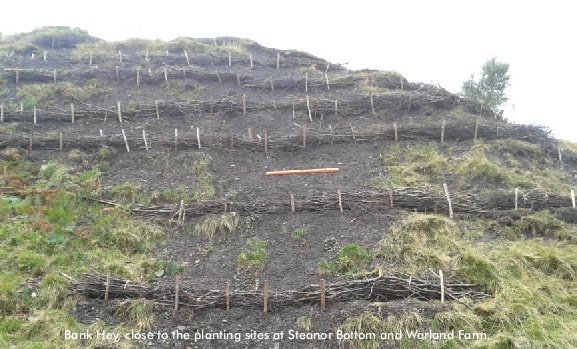New research from Leeds University into the impacts of permitted heather burning on upland peat bog shows that for the 20% biggest storms, the flow of water over land is higher than in areas where the moorland has not been burnt.
This will contribute to “flashy” river flows in the valleys below the moors, with the water level rising quickly and causing flooding.
The researchers conclude,
“We would expect these effects to have a larger impact on river flow as the proportion of the catchment that has undergone more recent burning increases (i.e. the shorter the prescribed burn rotation interval).”
The likely causes of this increased overland water flow are that prescribed burning – the controlled, so-called “cool burning” that Natural England allows in winter on protected sites like Walshaw Moor Estate – removes the rough understorey of dense vegetation such as Sphagnum moss and also compacts the upper peat. So instead of slow moving water that sinks into the peat, during intense rainstorms, water runs off the peat and pours into streams and rivers.
Dongria Kondh, speaking on behalf of the Source project, said,
“Now that new research shows a clear link between heather burning on the moorlands and flooding in the valleys, it is to be hoped landowners will take note and manage their land in ways that help to reduce the risk of flooding in the catchment.”
Key improvements to land management on upland peat bogs that the Source project are calling for in order to reduce flood risks are:
- rewetting the bogs, by blocking old drainage ditches
- mowing, not burning, heather; and using the clippings to help revegetate bare ground
- reintroducing sphagnum in rewetted areas
The Source project is carrying out practical work on natural flood alleviation measures with various partners including Yorkshire Water, Natural England and local landowners.
Calderdale Council is working on natural flood management strategy
Calderdale Council’s Countryside Service is currently employing consultants to develop a natural flood management strategy.
Details of the natural flood management strategy were not available when Calderdale Council’s Economy and Environment Scrutiny Committee met on 13th August to review the Council’s Flood Recovery Programme.
Hebden Royd Councillor Elizabeth King has since found that Calderdale Council’s Natural Flood Management (NFM) Strategy is at an early stage. They are currently collating datasets for a computer modelling exercise to identify four key areas where NFM interventions are likely to have the most impact on flooding in the Upper Valley above Brierley weir. Calderdale Council is working towards a draft NFM strategy being ready at the end of November.
£15m shortfall on £20m flood alleviation and reduction schemes
The key message at the Scrutiny Panel meeting was that there is a £15m shortfall on four proposed flood alleviation and reduction schemes, that will cost about £20 million.
The Scrutiny Committee discussed sources of funding, that include the Environment Agency, the EU and a number of local and national funding sources.
The Council is also working with the Environment Agency, the Canal and River Trust, Yorkshire Water and the local community, with the aim of reducing the risk of future flooding and to lessen its impact when it does happen.
Councillors at the Scrutiny Panel meeting commented on improving the cleaning of road drains to improve run off but did not make any decisions about the Flood Recovery Programme. Public consultation is due to start on these schemes but no further details are available.
Other flood protection measures that will improve drainage and help to eradicate run off waters from the hills and overflow of the river and canal are funded, currently taking place and are due to finish next Autumn.
Updated 26 August with info about timescale for Calderdale Council’s Natural Flood Strategy


George says it all. Flood prevention should be from top to bottom.
Yes, whole catchment management is the (rather wordy) name of the game.
Read Feral by George Monbiot to understand the negative impact of swathes of heather and unrestricted grazing. And the positive impact of enabling the moors to return to a more natural state. A state, I think, that would support flood alleviation.